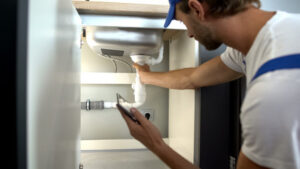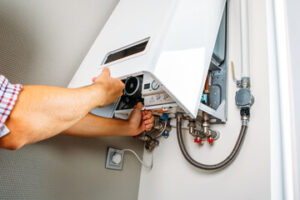Plumbing systems take away wastewater, supply hot and cold water, and regulate indoor climate through pipes, fixtures, valves and appliances. Plumbers install, repair and maintain these systems.

Plumber St. Petersburg FL understands how different types of systems work and be familiar with building regulations and codes. They need to have the physical strength and stamina for manual labor, and be comfortable working in tight spaces.
A plumber needs a variety of tools and equipment to install, repair, and maintain plumbing systems. These tools include pipes, fittings, fixtures, valves, and other hardware. Plumbers also use specialized tools to identify and troubleshoot issues with water pressure, temperature, and other components of a plumbing system.
Plumbers often use press fitting systems to connect piping quickly and securely. These systems create a strong, lasting seal that prevents leaks. A plumber may also use a hand auger or drain snake to dislodge and clear blocked pipes. These tools are often used in conjunction with a video camera to help locate the source of a clog or other problem.
Other tools a plumber uses include a pipe cutter, power drain snakes, and wrenches. A pipe cutter can cut through hard surfaces and tight spaces. Plumbers also use wrenches to turn and remove bolts, nuts, and screws. These tools have a wide range of adjustment and feature specialized, angled jaws for all types of tasks.
Plumbers can also use a crimp tool to join multiple pieces of metal or other material together. This is especially useful for joining PEX piping, which is becoming increasingly popular in residential and commercial plumbing. A crimp tool works by deforming or squeezing one or both of the joined parts to hold them together. Plumbers may also use a hydraulic pipe bender to twist and curve pipe lines.
Finally, a plumber may need to use a gas detector to test for the presence of carbon monoxide and other dangerous gases. These devices are typically located near boilers, water heaters, and furnaces.
Plumbing is a hazardous job, and plumbers must wear safety gear to protect themselves from bacteria, viruses, germs, and chemicals. This includes a mask, goggles, and gloves. Additionally, plumbers should wear heat shields when soldering or working with hot materials.
Tools
A plumber works with a wide range of tools to install, repair and maintain pipes, tubes and supply lines. Pipework tools include cutters, a hacksaw and a pipe wrench. A plumber also needs a variety of other hand tools and specialty hardware. A deburring tool is used to smooth modification marks on pipe edges, and a reaming tool enlarges holes or openings in pipes. A roll of emery cloth is also a must for all plumbers, as it is an abrasive material used to remove burrs on pipe threads.
Other tools a plumber might use include tongue and groove pliers (also known as Channellocks or multi-grips), which have jaws that lock into place and remain parallel to grip materials. This provides extra leverage and makes it easier to turn or hold nuts and bolts. These pliers can also grip or rotate irregular objects and clamp materials. A set of needle-nose pliers is another handy plumbing tool that features long, tapered jaws that can get into narrow spaces where other types of pliers are unable to reach.
Wrenches are an essential part of any plumber’s toolkit and the most common type is a pipe wrench. It’s designed with a long handle that allows the user to tighten or loosen pipe fittings and nuts in hard-to-reach places behind sinks and faucets. Plumbers also need a set of adjustable wrenches, which have jaws that adjust to different fastener sizes. A strap wrench is a different type of wrench that has a durable strap attached to the handle for evenly distributing force when turning fasteners in tight spots.
Plumbers often work with screws, and a basic screwdriver set is necessary for the job. A typical set includes open-end, box-end, socket tube, radiator and chain wrenches, as well as Allen, basin and strap wrenches. Plumbers might also need a stubby screwdriver set, which is smaller than standard screwdrivers and can fit tiny screws found on cabinet hinges.
A plumber must also have access to pipe thread sealant, which creates a leak-free seal on threaded pipes. This is especially important when re-installing old pipes or when repairing broken threads on new pipe installations. A plumber should also have a flow rate calculator and a way to convert units of measurement.
Safety
As plumbers work in people’s homes, they must be aware of and ready to face a variety of safety risks. Some of these include:
Exposure to bacteria and germs: Plumbers have the potential to come into contact with contaminated water, rodents and other debris that can cause diseases such as Campylobacter, E. coli and Giardia duodenalis. This can lead to diarrhoea, stomach pains or cramps, dehydration and even fevers. It’s therefore important that they wear face masks and gloves and keep their tools clean.
Tools: Plumbing technicians are responsible for using various complex and specialized tools that can be dangerous in the wrong hands or used incorrectly. This puts them at risk of injury from abrasions, cuts, punctures, burns and other injuries. It’s crucial that they understand the safety measures for each tool they use and adhere to them, especially when working around flammable or combustible materials such as gas lines and steam or hot water pipes.
Working at heights: Plumbing jobs often require a plumber to climb ladders or scaffolding in order to reach difficult spots. This can pose a risk of falling which can cause serious and fatal injury. It’s recommended that plumbers take every precaution when working at heights and always use a harness, secure themselves to the equipment they are using and ensure there is someone to help them in the event of an emergency.
Eye injuries: Due to their constant exposure to foreign matter, chemicals and bacteria, plumbers are at risk of sustaining eye injuries. This can include abrasions, cuts and scratches as well as infections from bacteria or germs that get into the eyes through openings in the skin. It’s therefore important that they wear protective glasses when needed, especially when working in confined spaces or near liquids or hazardous materials.
Slips and falls: Plumbers are also at risk of slipping or tripping when working in awkward or tight spaces. This can result in bruises, sprains, fractured bones and other injuries. To avoid this, plumbers should use appropriate footwear and be careful when walking on slippery surfaces or in wet areas. They should also be mindful of their surroundings at all times and avoid distractions to prevent accidents from happening.
Licensing
There are several different paths to becoming a plumber. Some enter through a formal apprenticeship or trade school program. Others acquire the skills through hands-on training with a journeyman plumber. Some states require that plumbers obtain a license to work independently. This usually requires passing a written exam that tests technical know-how and knowledge of local plumbing codes. Additional certifications may improve a plumber’s marketability and pay.
Plumbers work in a variety of settings, including residential and commercial buildings. They often install systems in new construction, and they must be able to adapt existing systems for renovation projects. This can involve modifying pipes and fixtures to accommodate new appliances or changes in the building’s use. Plumbers also must be able to read blueprints and understand building code requirements.
Some plumbers specialize in specific types of plumbing systems. For example, one may focus on water supply or drainage systems for manufacturing facilities. They may also work on fire sprinkler systems in office buildings or hospitals. Plumbers who work on large-scale industrial plumbing equipment often need to collaborate with engineering teams to design the systems and ensure that they are integrated into the overall facility.
Plumbing technicians must be able to communicate effectively with customers. They must be able to explain complex procedures in layman’s terms and answer questions thoroughly. They must also be able to estimate project costs and timeframes accurately.
Another essential skill is critical thinking. This allows a plumber to weigh alternatives and choose the best solution for each situation. It is important for plumbers to be able to solve problems quickly and efficiently, especially when working under pressure.
Finally, plumbers must have physical strength to handle tools and heavy equipment. They must be able to climb ladders and stairs, and they may need to lift heavy objects. Plumbers who work on sewage systems must be aware of the potential risks associated with working around human waste. They can be exposed to infectious diseases such as cholera, typhoid, hepatitis, polio, cryptosporidiosis and ascariasis. These infections are typically transmitted through contact with fecal matter or vomit that enters the sewer system.
